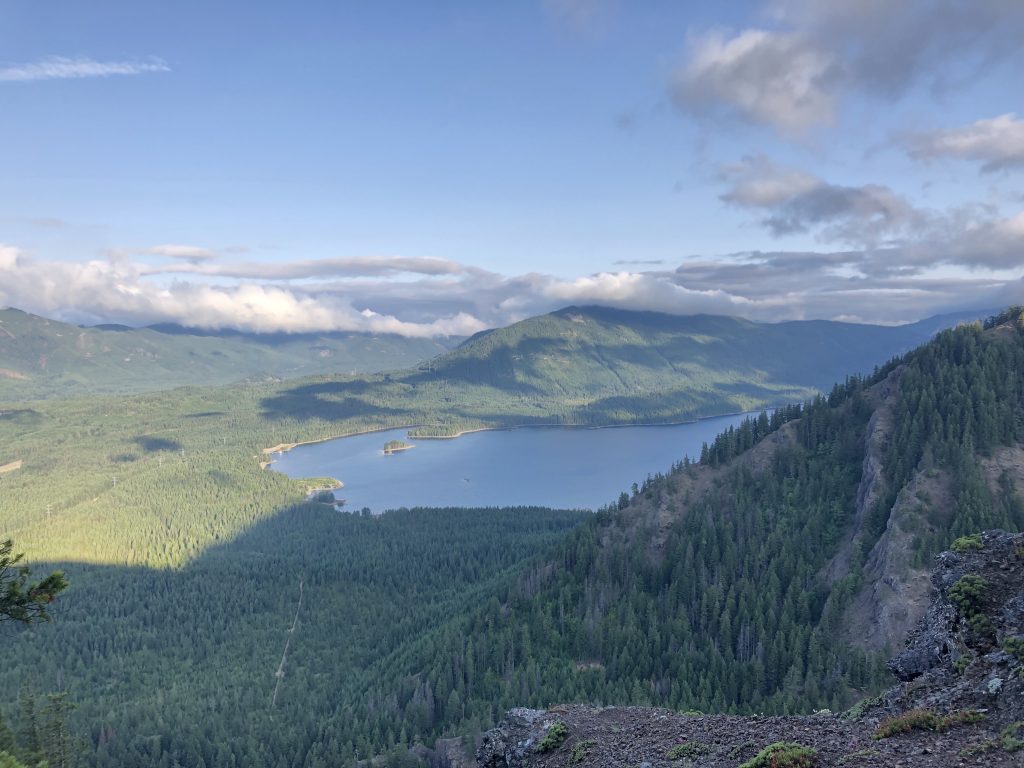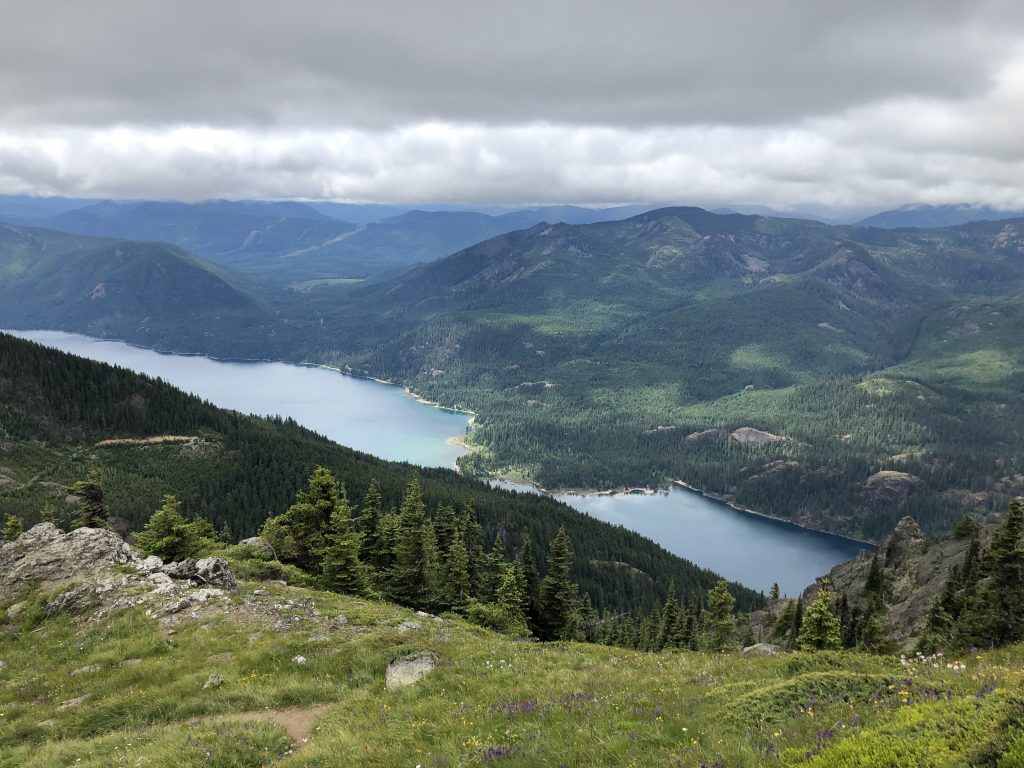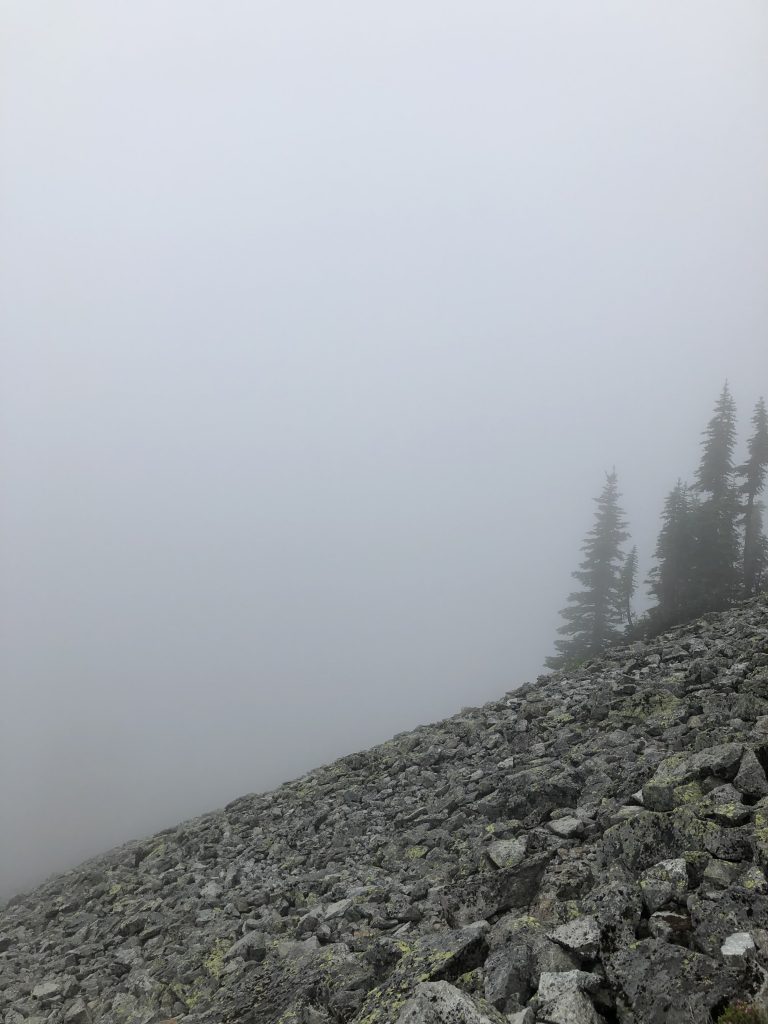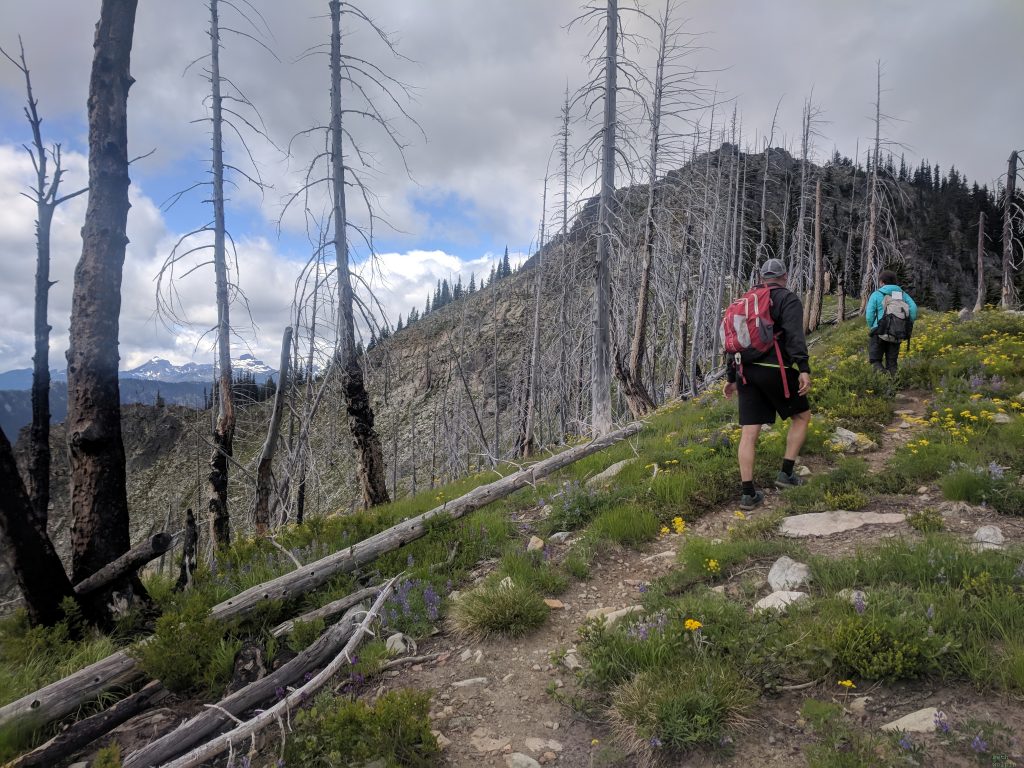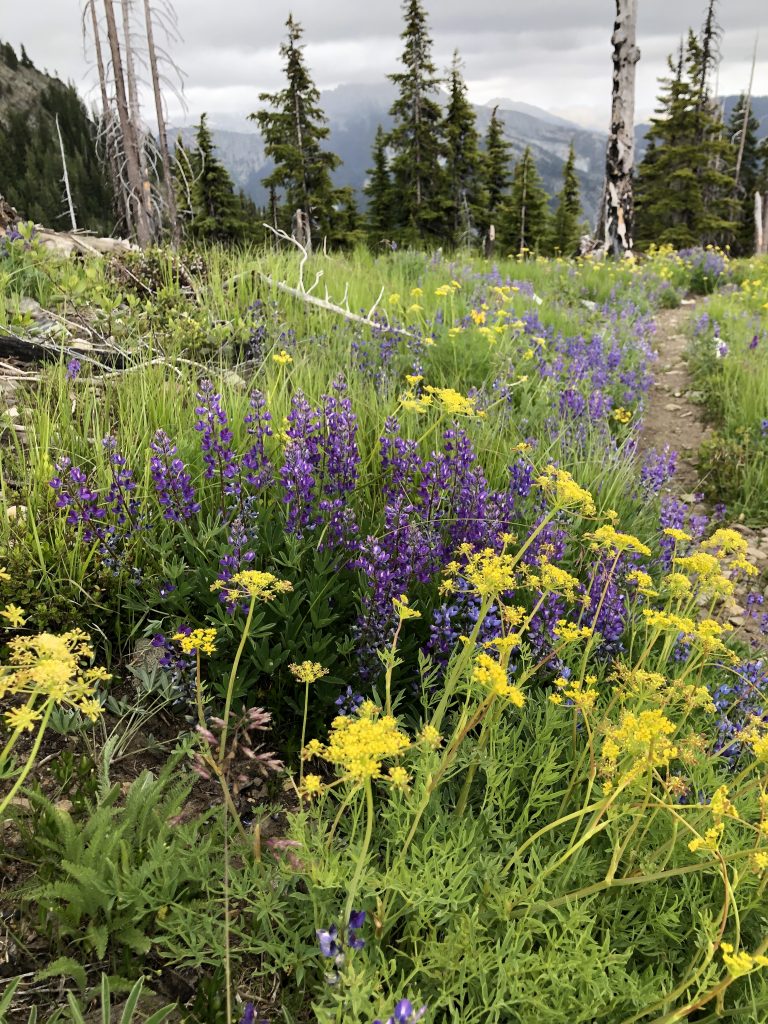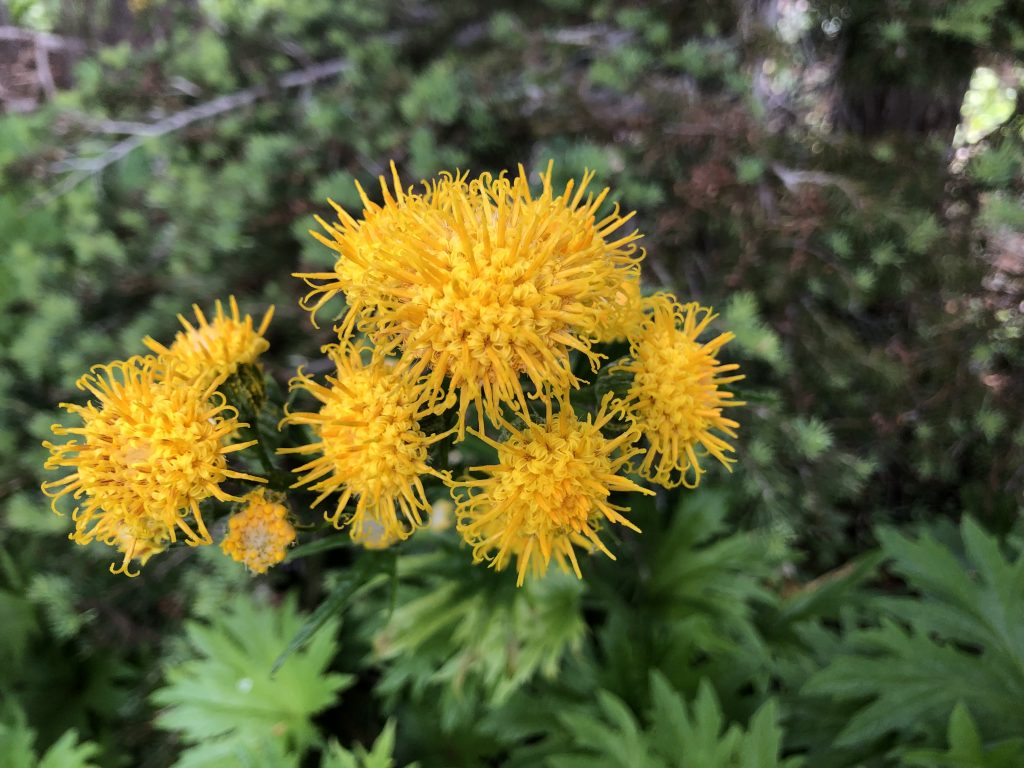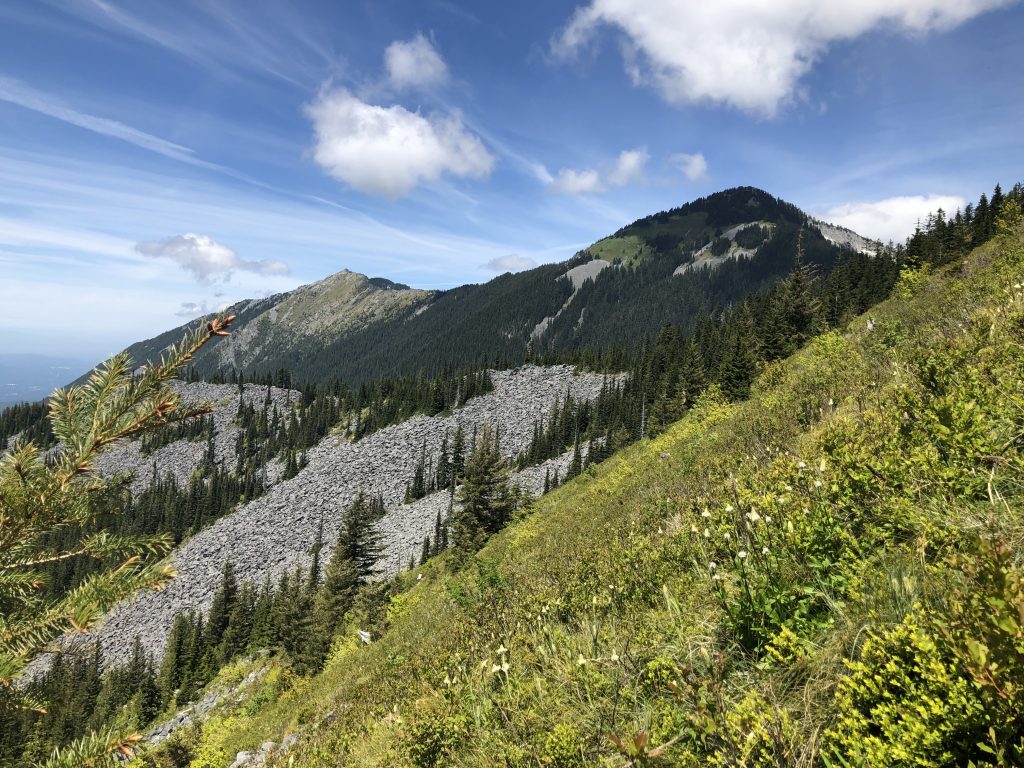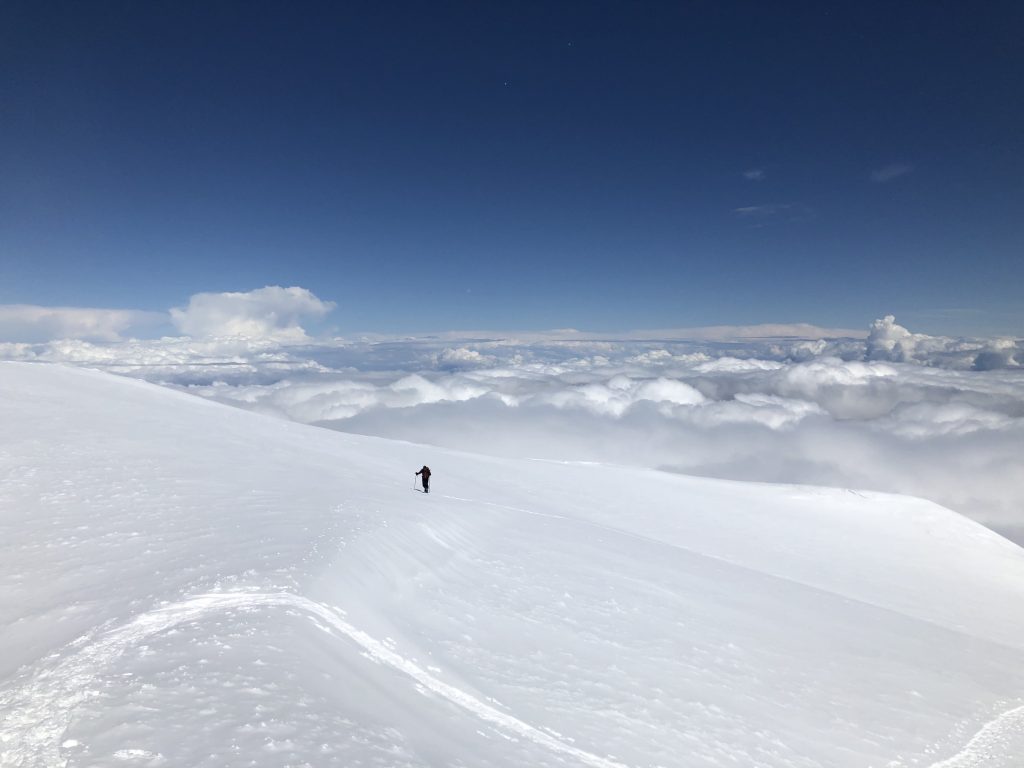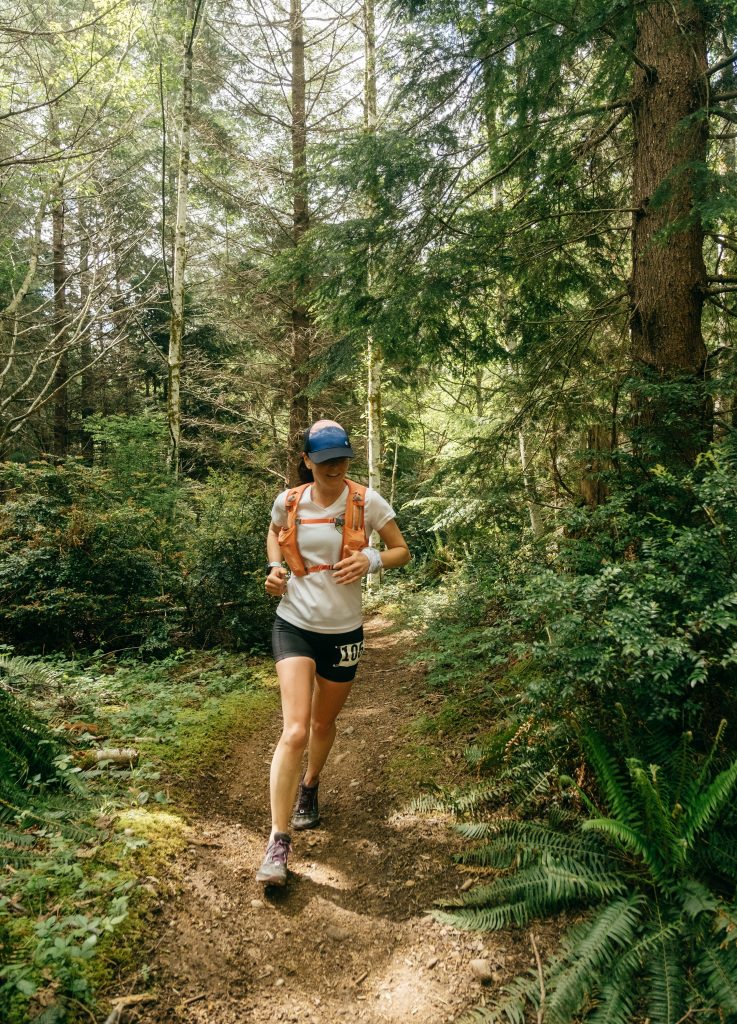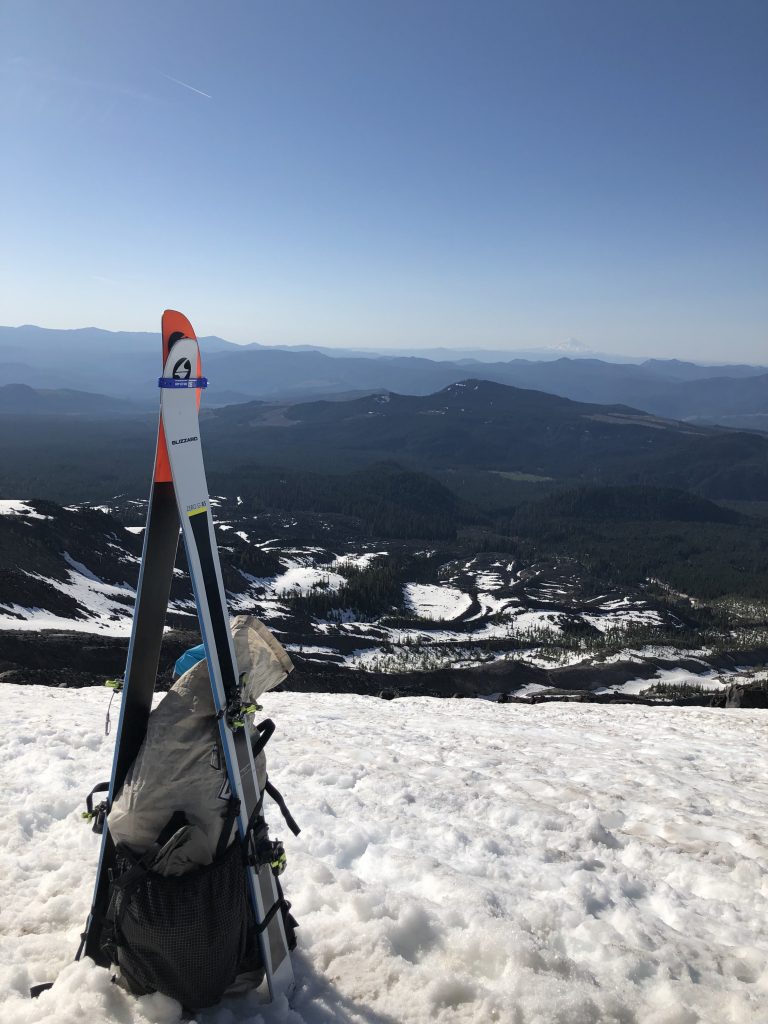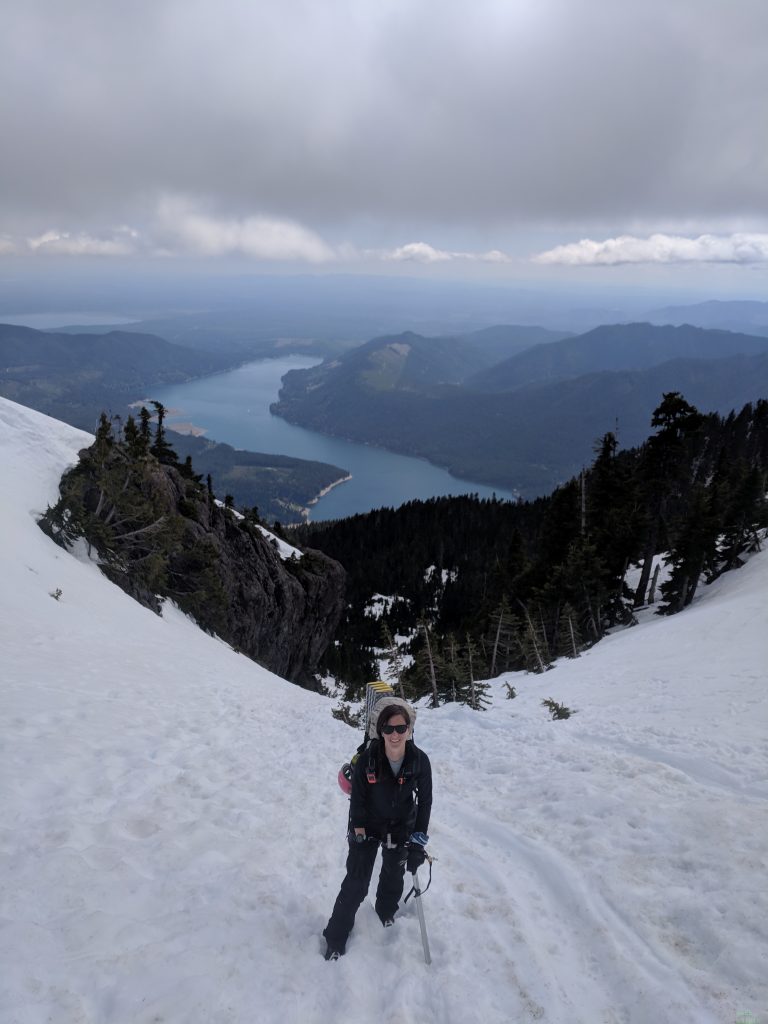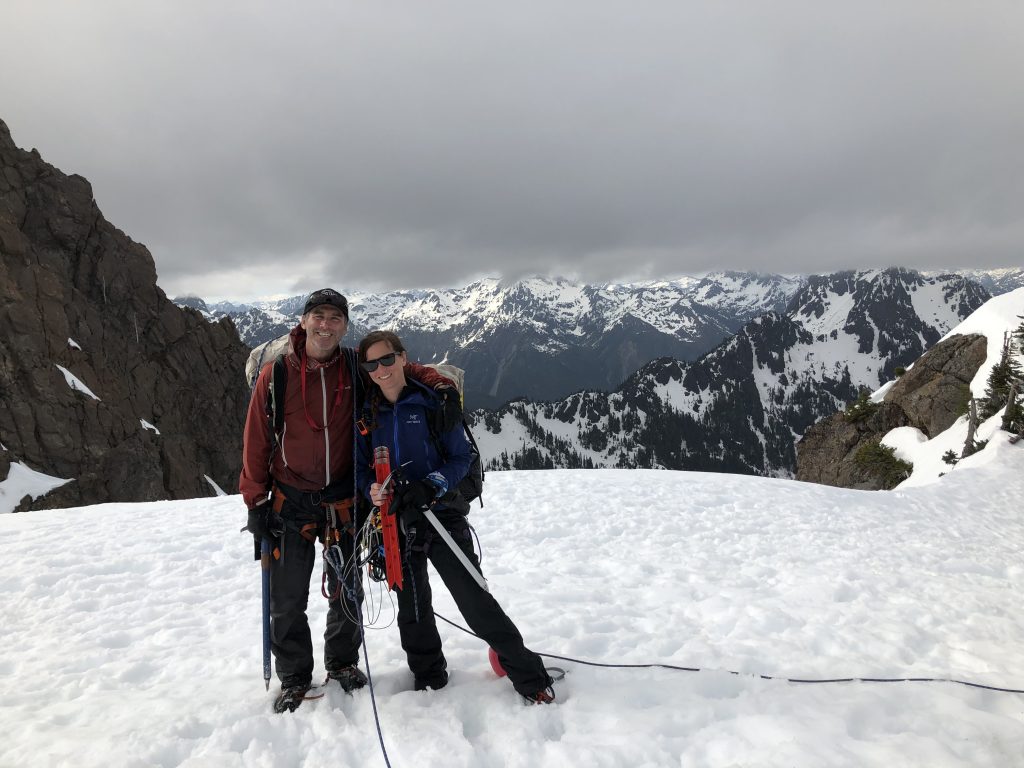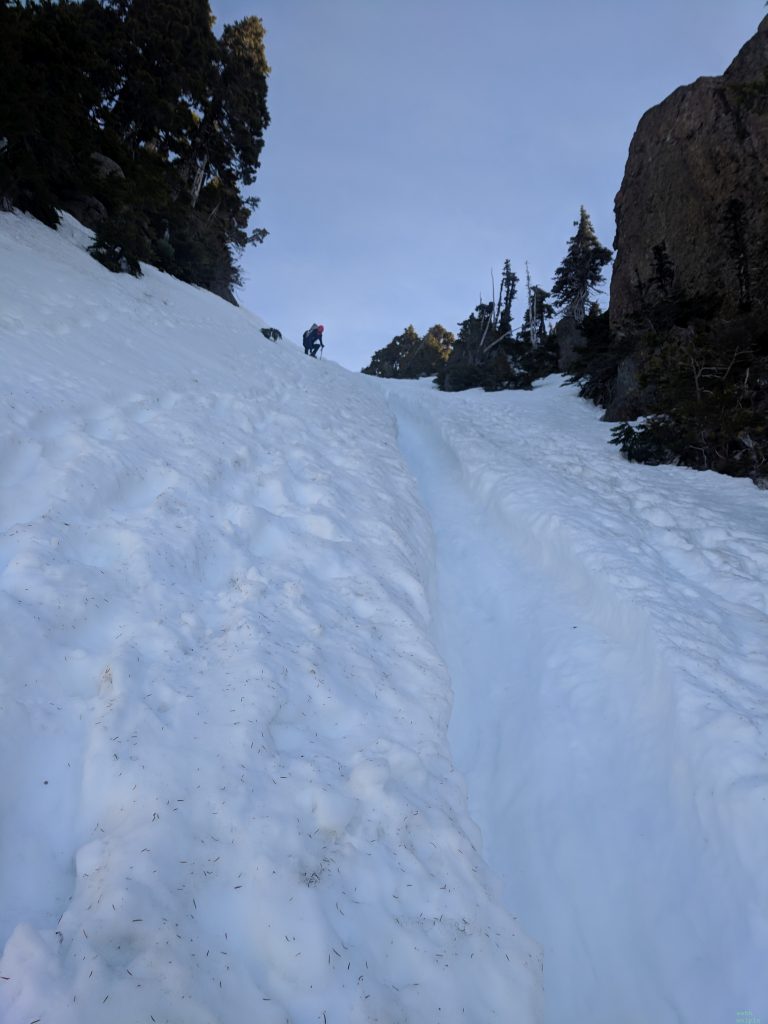Peak 21: Tahoma (Mt. Rainier)
Elevation: 14,441’
Total Mileage: ~15
Elevation Gain: 9043’
Date: 26-28 July 2019
Introduction
The morning after my campus interview at the University of Washington Tacoma, in January of 2014, I pulled back the curtain of my hotel room to find an enormous, snowy volcano looming out the window. I gasped, breath caught in my throat. I had simply never seen anything like it. While I had visited Paradise the year before during a vacation, and saw the summit from Panorama Point, clouds had cloaked it throughout the rest of the trip. I never had that view of the mountain dominating the landscape. With such an impressive prominence (13,212’!!!), Tahoma rises significantly above the surrounding sea-level landscape. While many other mountains might be taller, Tahoma’s prominence lends it an awe-inspiring aura.
I never dreamed that I would actually stand on top of it.
For years, I told myself that I had no interest in climbing Mt. Rainier. I’m afraid of heights, have crippling vertigo, and simply never had the urge to catch the view from its summit. Nevertheless, the mountain held my imagination, and, to this day, I never cease to gasp when I catch a glimpse of it. I hope never to lose that sense of awe at its majesty. Perhaps I’m biased, but I think Tahoma is the most beautiful mountain in the world, and I deem it a privilege to live in its shadow.
As the mountains of the Pacific Northwest became my playground, occasional thoughts of summiting Tahoma crossed my mind, but never quite seriously. With some rock climbing and multi-pitch experience, the occasional thought grew to the faint tinges of an urge. By the time I started my 40 Peaks for 40 Years challenge, I knew that this summit had to be included. The prospect was equal parts thrilling and terrifying: the textbook definition of the sublime.
To prepare, I used other climbs (Loowit, Klickitat, and Ellinor, in particular) as training, and I took an Introduction to Crevasse Rescue course. It was important to me to come in as prepared as possible. Two friends, Harrison and Noel, would lead the climb and include a day of glacier school at base camp. I’m someone who likes to be fully prepared for any endeavor, to give myself a bit of reassurance that I can make it through. As summit day drew nearer, jitters set in, but the jitters-because-I’m-excited-jitters were still stronger than the jitters-because-I’m-terrified-jitters.
Paradise to Camp Muir
As I drove to my friend Jen’s house, the seat belt alert sounded the entire time. My pack, sitting shotgun, was so heavy that the sensors thought that it was a 49-pound human. It was incredible that I would soon be toting that thing up the side of a mountain. I had never carried anything remotely that heavy before, even on extended camping trips.

Photo credit: Kind person at the Paradise Visitor Center
Setting out from Paradise, I staggered under the weight. It truly took my breath away to carry such a heavy pack. All we could do was laugh and keep going. Day hikers stopped us along the way to ask where we were heading and how much our packs weighed. They either told us we were strong and tough, or that we were nuts. One parent explained to their daughter what we were doing, and I thought how cool it would be if that image stuck with her and sent her into the mountains one day.

Photo credit: Jen Schneider
We caught the rest of our party at Pebble Creek, where we turned off the regular trail and moved up the snow field below Camp Muir. I was growing accustomed to the small-human-sized load on my back, and the views of the Tatoosh Range, with Klickitat and Loowit beyond to the south and east, and Tahoma rising to our left, served as a nice distraction.
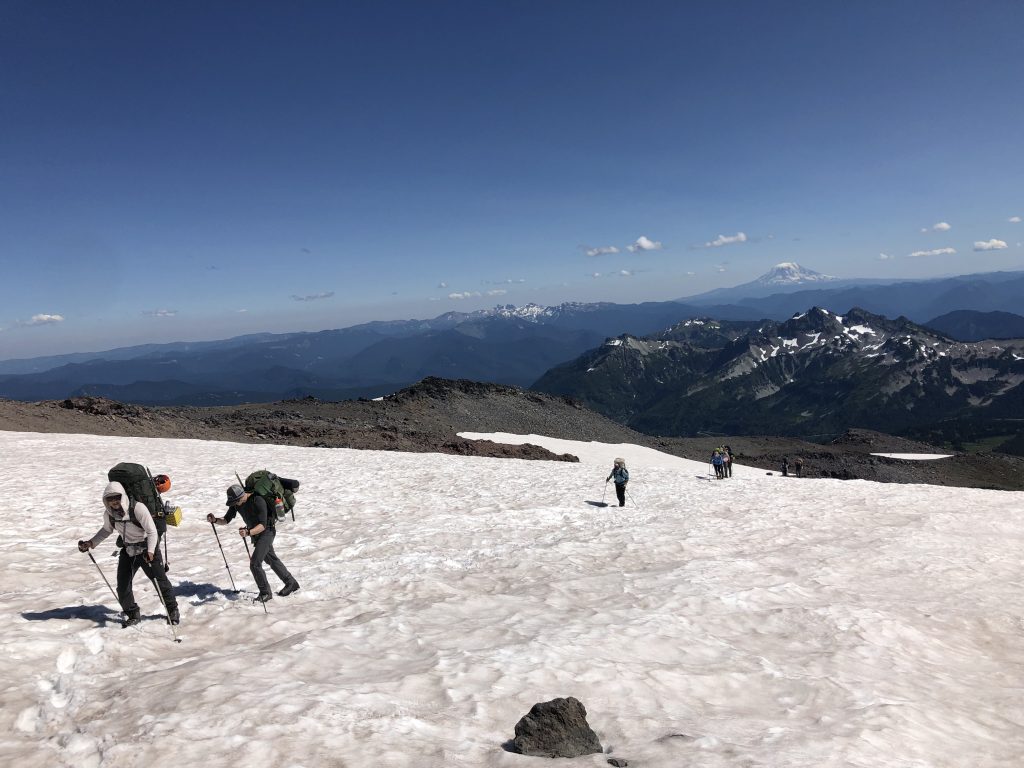


Camp Muir comes into sight long before you reach it, and descriptions that suggest this makes for quite a tease on the long final slog are accurate. Of course, you’re too excited at this point to mind. Our permits allowed us to camp at Muir, so we scoped out options upon arrival and began the work of making camp in the snow. Harrison whispered the happy news to me and Jen that there was room in the climber’s hut. We didn’t think twice and giddily ran up to stake out a spot. We didn’t mind not getting the tent camping at base camp experience. The weather forecast for the night—strong sustained winds with serious gusts—was enough to convince us that we had no qualms about sleeping indoors. Plus, the climber’s hut has its own charms and sense of adventure.

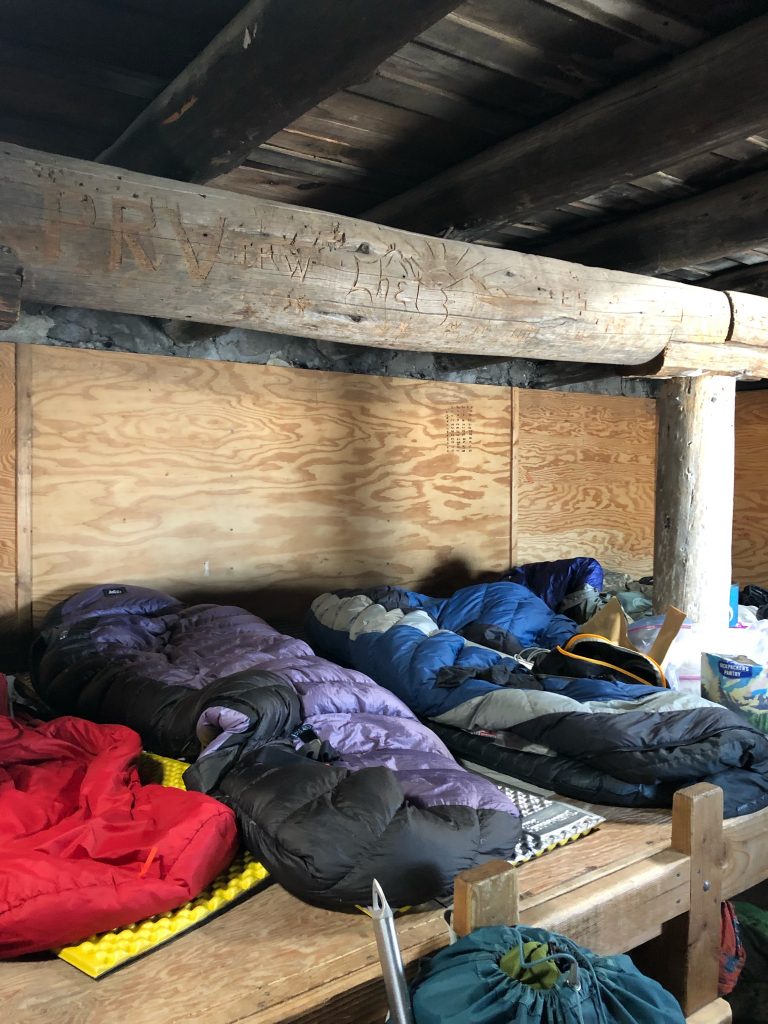

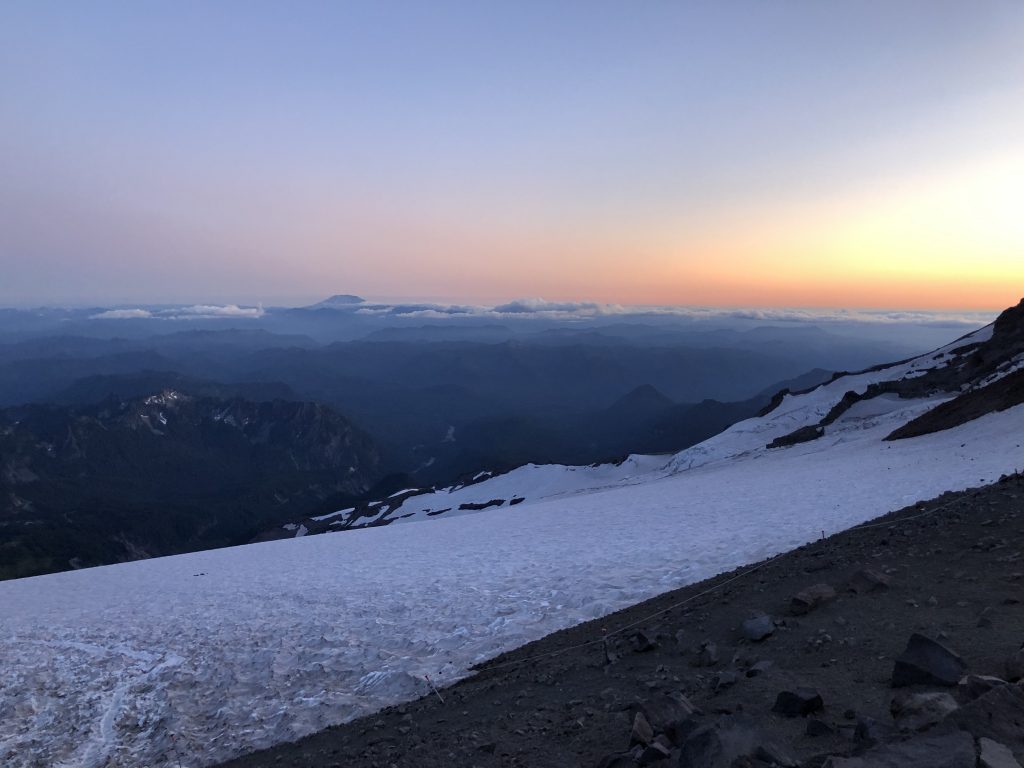
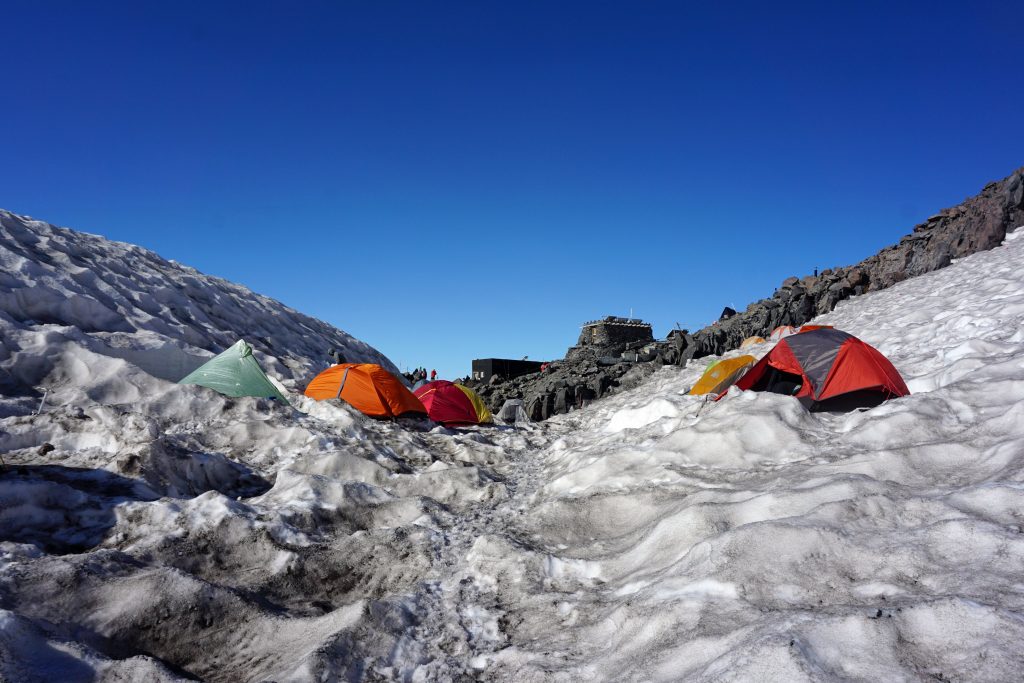
Since we didn’t have much set-up time, Jen and I helped the rest of the team make camp and boil water. Harrison carved out a kitchen, complete with snow bench and table for preparing food and boiling snow. We would spend most of our free time boiling snow, as this is the only source of water at Camp Muir and above. After pitching in for team chores, we headed back to the hut for dinner and to get a good night’s rest. We’d need it. We mingled with other climbers in the hut for a while, and everyone turned in early, but not before marveling at the alpenglow that bathed the mountains in magic hour pink. At 10,080 feet, Camp Muir was the highest elevation at which I had ever slept.
Jitters Meter: Excited Jitters > Terrified Jitters
The wind raged that night, waking me occasionally and instilling gratitude for the relative comfort of the hut. In the dark hours of the night, a team of climbers stumbled in and quietly claimed a spot on the floor. I couldn’t imagine what their trek up from Paradise must have been like in this weather but was sure they must have felt sweet relief finally reaching the hut.
Over the Snow Bridge and into the Crevasse: Or, Doubts Emerge
Harrison encouraged us to sleep late into the next morning, as we wouldn’t get much sleep Saturday night. After a lazy morning, we trekked down to our team’s camp to help with the daily chores. The climbing ranger on duty stopped by to update us on weather and mountain conditions. If this little pep talk was meant to instill sheer terror in us, mission accomplished. The ranger explained that the freezing line was coming down to a lower elevation that night, which would create dangerous “slide for life” conditions. “The ground will be too frozen for your ice axe to do any good, making it impossible for you or your rope team to self-arrest.” He conjured visions of us cascading off the side of the mountain, futilely trying to gain purchase in the ice with our axes, dragging our rope team helplessly along with us, and plummeting to our bloody death below. He didn’t mince words, and he made it sound like our chances of ending up in a slide for life scenario were quite high.
Jitters Meter: Terrified Jitters. Period. (Excited Jitters not strong enough to even faintly register on the scale.)
Pep talk completed, the ranger ambled off to share the great news with other teams. A silent but very palpable tension hovered between my team for what seemed like an eternity. Finally, I broke the tension in the only way I knew how, by making a joke of it: “Well, I’m terrified after that pep talk!” I said, laughing. Others nervously laughed and agreed. It felt good to know that I wasn’t the only one inwardly freaking out. I would say that I was figuratively shitting myself in that moment, but that metaphor is going to be much more apt a bit later in this narrative.
Harrison and Noel both reassured us that the ranger was just doing his due diligence by scaring us with the worst-case scenario, and that it was his job to remind us that we were undertaking a dangerous endeavor. Their calm cool and years of experience helped to quell some of our anxieties, but my nerves were definitely shaken. Doubts crept in, and thoughts of bailing began to form, but Noel and Harrison’s reassurances were enough to keep me committed to the climb. Noel explained that we would place pickets anyplace where a fall could prove fatal. It was enough to keep my fear at bay—at least far enough at bay that I wasn’t going to bail. With that, it was on to glacier school.

There’s nothing better for ensuring that your nerves continue to fray than to run across your first ice bridge. Noel demonstrated good crossing form, emphasizing the importance of building forward momentum and moving quickly. My brain simply could not compute that, and my body shook as I teetered across in the exact opposite way from what Noel had instructed. My nerves continued to unravel, but I worked hard to maintain a decent poker face.

Finding a suitable slope, we practiced self-arrest from a few positions. I nailed the self-arrest but the ranger’s words echoed in my head, convincing me that my solid self-arrest skills wouldn’t matter in the slide for life conditions waiting above.
There’s nothing better for ensuring that your already frayed nerves continue to deteriorate than letting someone throw you into a (seemingly) bottomless crevasse. While I did take an intro crevasse rescue course, and I successfully hauled myself up and out during our practice runs, those practice runs were in a climbing gym, and the crevasse was just a bouldering wall.
I stalled by helping set up Z pulleys and hauling out the other brave souls. As each team member took a turn, my anxiety increased, knowing that soon it would be mine. Eventually, I turned to Harrison and said in a lowered voice, “Harrison, my nerves are just completely shot. I can’t do it. I just can’t do it.” In his characteristic calm and reassuring tone, Harrison said, “No problem. Do what you’re comfortable with.” As the last team member who wanted to go in emerged from the crevasse, I had a change of heart. Or, perhaps more appropriately, my ego kicked in. I wasn’t going to wimp out.
“OK Harrison, lower me down.”
“Alright!!!”
Crawling to the edge of the precipice, another team member, Travis, gave me a safe word: “When you’re ready to come out, just say ‘Unicorn.’” The team lowered me into the abyss. When being lowered into a seemingly bottomless crevasse, it’s important not to look down, especially if you’re terrified of heights and your nerves are already frayed. As soon as I was over the edge, I looked down. It was the scariest sight thine eyes hath ever beheld. The walls of snow were tinged with blue, and my eyes traced them down as far as I could see before it dissolved to black nothingness. There was no visible bottom, just who knows how many hundreds of empty feet in the void below. I crammed my crampons into the side of the crevasse.
“Unicorn! Unicorn!! Unicooooornnnn!!!”
Harrison crawled out to check on me while Travis laughed, hanging over the edge and snapping photographic evidence that I really did allow myself to be lowered into a crevasse.
“Hey girl! How’s it goin’ down there?”
“Harrison, this is awful!” I laughed but was serious.
“OK, you’ll have to hang out for a few minutes while we get things set to haul you out.”
I morbidly looked down again. And again. I couldn’t help it. My brain couldn’t fully process the bottomlessness. While I had wanted to practice my self-rescue skills, I was too far gone to do so now. It’s one thing when you’re in a gym. Hanging above oblivion is quite another matter. I reassured myself that, if I actually fell into a crevasse, that I would be capable of getting myself out. Knowing that there was a team set up to pull me out now, though, zapped any motivation for practicing my self-rescue skills.

I heard voices shouting instructions, which Travis relayed: “OK, you’re going to drop a bit at first before they can pull you out.” I knew this was coming, having helped haul others out, but being on the other end of the rope put the matter in a different light. That drop felt like a giant lurch down into the gaping maw of the crevasse. Finally, the tension on the rope tightened, and I slowly ascended to the lip. It was a matter of seconds but felt like hours. Collapsing into safety, Harrison crawled over and slapped my leg with excitement. Everyone was laughing, because they could appreciate just how scared I’d been. Exasperated, I laughed and asked, “Why did I look down?! As soon as I got in, I looked down!”
Calling it a day, we traversed back across the snow bridge and began making preparations for our summit bid. Harrison and Noel walked us through the plan. At one point, Noel mentioned that there would be some places that it would be too dangerous to take time to place pickets, because the danger of rockfall far outweighed the danger of a potential fall. My face must surely have blanched.
“How do we get through those sections safely, then?” I ventured.
Looking me dead in the eye, Noel explain, “In those places, you just can’t fall, Ellen.”
[Terror meter broken.]
I spiraled. We adjourned to eat an early dinner so that we could try to be in bed by 7:00 p.m. We’d be meeting up at 11:00 p.m. to get roped up and start our ascent by midnight. That evening was a blur at best. I don’t remember eating or talking. I just recall being gripped by thoughts of useless ice axes and replayed a looped video of myself sliding off the mountain. I wondered if I would scream as I slid, ice axe as useful as a donut in my hands, or if I would silently fall away over the edge.
By the time that I crawled into my sleeping bag, I decided to abort. I was convinced that the conditions were too dangerous, and that my chances of dying were larger than I’d accept. Reaching the summit wasn’t worth it. The possibility of dying on the mountain struck me as very real and very possible. I participate in risky endeavors, but I do my best to mitigate risk, and I don’t do things where I feel that my chance of dying outweighs my chance of survival. The ranger’s words, coupled with Noel’s hardly reassuring suggestion to “just don’t fall” were enough to send me over the edge. I was bailing on the climb, and I was just fine with it. A small sense of relief overtook me, calming me a bit, giving comfort in knowing that I wasn’t going to have to go up the mountain.
Summit Day
When our alarms went off, I went through the motion of getting dressed and eating breakfast. I loaded my pack as if I was climbing, but I had no intention to follow through. When I got to camp, everyone was getting tied into their ropes. I told Harrison and Noel that I just couldn’t do it. I was too scared and it didn’t seem worth it. They tread a fine line between trying to reassure me, while also letting me know that they wouldn’t force me to go.
“I don’t want to rope up, then get part way up and not be able to make it. I don’t want to ruin the rest of my rope team’s climb.”
“If you get up there and want to turn back, at any point, I will cut the rope and bring you down myself,” Noel offered. It was reassuring, but I would perhaps endanger the rest of the team by taking away one of our two experienced leaders.

Everyone was roped and ready, and Harrison was doing some final checks. Without skipping a beat, he said, “Jen, I need you to take this extra water in your pack. Ellen, I need you to get tied into this rope. Justin, I need you to…” There was something in the way that Harrison said it, so matter of fact, so calm and collected, yet also like someone in charge whose orders you’re supposed to follow without protest, that I found myself tying into the rope. Within minutes, we were off.
Camp Muir to Disappointment Cleaver
We would follow the most traveled, and probably easiest, route up the mountain: the Disappointment Cleaver route. (Here’s a cool video overview of the route.)

Heading out of camp, we passed under a wall of rock that would prove increasingly more dangerous as the day warmed, and even at night, we wouldn’t be able to stop through this section. In fact, we would need to move through it as quickly as possible to mitigate any risk of rockfall (rockfall being the most dangerous aspect of the DC route.) The large boulders strew about the side of the worn path in the snow served as a reminder of this risk as we moved briskly through this section.

We traversed across the Cowlitz Glacier and up the pass to Cathedral Gap and Cathedral Rocks Ridge. Switchbacking up to the pass on dreaded scree, I kept my head down and focused on Noel’s heels in front of me. As we neared the top, two women came flying past us: it was Kaitlyn and Alex, working on their second summit of their Infinity Loop (climbing up to the summit, going down the other side, running half of the Wonderland Trail around the mountain, summiting again, going down the other side, and running the other half of the Wonderland. Wow.) I felt so impressed and humbled by them, but I reminded myself that it took all I had just to be going up once.
We took a brief break at the top of Cathedral Gap, and Noel checked in with me. He said, “Let’s just get to the next break stop, and we’ll assess from there and decide whether or not to turn back.” Having a small goal helped me to move forward. I wasn’t climbing to the top; I just had to get to the next rest stop. From there, we traversed the Ingraham Glacier past Ingraham Flats, which serves as a high camp along the DC route. Pins of light punctuated the curtain of darkness, as climbers zig-zagged up the mountain ahead of us. That’s one image that will remain forever etched in my inward eye.
We weren’t the fastest group on the mountain, and others overtook us. This included guides short roping their clients up. It was a little surreal to see these burly mountain guides dragging their clients up behind them. I’m certainly not in a position to judge, but the clients struck me as just having to hang on for the ride while the guide pulled them up. My team leader was very much responsible for mentally pulling me up the mountain, but I was glad that at least my body was doing all of the physical part.
As we traversed toward the foot of the Cleaver, a wall rose to our left; we followed a narrow foot path, and there was a drop to our right. Fortunately, it was pitch black, and I couldn’t see what lay below. I kept my headlight trained on the ground in front of me, focusing both my mind and eyes on the tiny circle of light in front of me. Breaking my trance, Noel called back, “Here’s our first crevasse. Ellen, just build up momentum and jump over it.”
Instead, I stopped dead in my tracks, digging in my heels and refusing, like a mule. Eff that. No way. There’s an enormous (to me) gap in the ground that drops into oblivion, and I’m not taking another step. No way. Nope.
“I can’t do it Noel. I can’t. I just can’t do it!” The panic in my voice made it unrecognizable to me, like it was someone else talking.
“One, two, three, go!” He tried.
Nope.
“One, two, three, go!”
Nope.
And then, inexplicably, I leapt. I don’t know how to explain what happened other than to say that for a brief moment, my brain compelled my body to move, and then my brain shut off so as to foreclose any counterarguments.
I’ll quit with the jitters meter and just say that my jitters were off the charts for the entire ascent. Never in my life have I been so terrified, and never have I been terrified for such a long and sustained period of time. This made my 5-pitch climb up Cat in The Hat at Red Rocks seem like a breeze. Every step was agonizing. I couldn’t imagine having to leap more crevasses along the way. I couldn’t fathom even making it to the next rest stop. I wanted to turn around and felt a leaden dread with each step forward. This was, without question, Type 3 Fun (that is, something that isn’t fun, ever; not even in hindsight.) I would never, and I mean never, do something like this ever again. That phrase looped through my mind for the duration of the ascent.
When we reached the foot of Disappointment Cleaver, I was exhausted from the emotional toll of the climb. I was ready to quit, but Noel once again said, “OK, let’s just get to the top of the Cleaver, and then we’ll reassess. Just get there, and we’ll decide if we keep going or not.” It’s the sign of a good leader when someone, with a few simple words, can convince you to push past that which feels insurmountable. I agreed to keep going.
Then, he added, “Now, Ellen, there are a few places through here that are some of those ‘just don’t fall’ spots, so, don’t fall.”
I had already committed to going forward, so it didn’t matter how terribly those words rang in my ear. While I had been shitting myself figuratively up to this juncture, I now also had to refrain from literally shitting myself in fear. It is the first time in my life that I fully understood the source of that phrase. In addition to fighting the fear gripping every part of my being, I also had to scrounge every last shred of will and energy to avoid pooping my pants while tied on a rope connected to four other adult humans.
As we unroped to navigate the Cleaver, which becomes a rock scramble, Harrison took a celebratory moment to congratulate us: “You made it through what everyone says is the scariest part! Nice work, Team!” I tried to find comfort in that but had to make a big effort not to allow myself to dwell on the fact that we would have to go back through there again on the descent—and at that point, we would actually be able to see what was so scary about that section.
Scrambling up the Cleaver, I worked hard to keep up with Noel. I wanted to follow his footsteps and take the best path up through the rocks. He moved much faster than I typically would while scrambling, so it was a delicate balance of trying not to go uncomfortably fast while also not getting dropped behind. Occasionally, he would pause and say, “OK, Ellen, this is one of those ‘don’t fall’ spots. Just keep to the left, and don’t look down to the right.” Those words would send my nerves spiraling, but the only way was forward. Again, it was too dark to see what awaited if I went too far right, but I assumed it involved a very long drop down. After hearing this directive a few times, I started to wonder if ignorance might truly be bliss, and perhaps it would be best for Noel not to tell me “just don’t fall here.”
Ascending the Upper Mountain, One Snack Break at a Time
Cresting the top of the DC, we walked over to a flattish rocky area for a break. I felt completely frazzled and at my wit’s end. Noel and Harrison both came over to talk to me. Tears rolled down my face. “I’m just so scared, guys. I’m so scared. Every step is painful and takes everything I have to go forward.”
Trying to be helpful, Jen said, “What are you so afraid of?”
“Dying.”
“Why are you afraid of dying? It will be over quickly and then you’ll just be dead!” She said, laughing nonchalantly.
“Because I have too much to live for, and too many things left to do in my life!” I returned, anger rising in my voice. She realized her pep talk wasn’t helping, as my agitation grew.
“Look up there,” Harrison said, gesturing to the upper mountain. We can see the rest of the route from here. It’s just switchbacking up snow the whole way. Easy peasy. The hard part is over now.” Tears paused; my heart rate came a little more under control. I guess it didn’t look so bad from here.


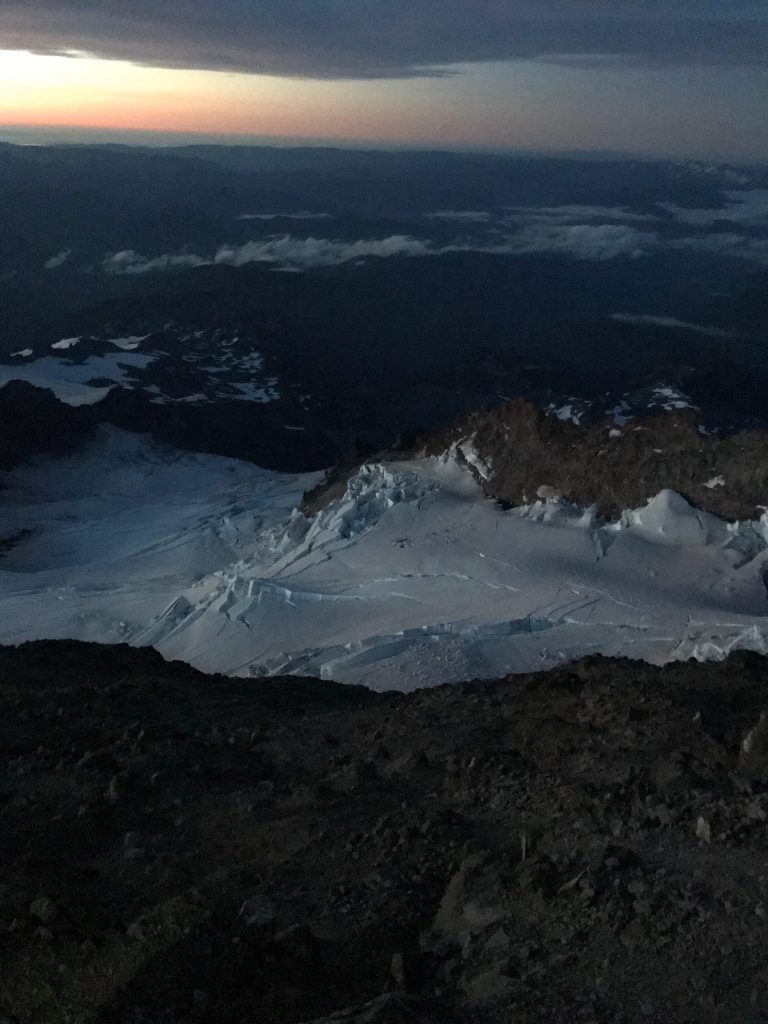

We took a snack break and watched the sun rise. Below, Little Tahoma stood like a spire, but it also seemed so tiny compared to the massive mountain on which we stood. My thoughts raced. I didn’t want to quit, but I was sincerely terrified of continuing. For good or for ill, my ego can be quite strong. In the end, it’s the main thing that prevented me from turning around. While the reassurances and support were key, when it came down to it, my irrational fear of failure and distaste for quitting are what ultimately convinced me to stick with it. I sensed that I would never forgive myself for quitting, strong as my fear was. Perhaps this is a character flaw, but I also knew that Harrison and Noel wouldn’t be taking us up here if they thought we wouldn’t be coming back. Of course, accidents can, and do, happen, but they felt the conditions were as safe as they were going to be (and the freezing line had not come down as low as the ranger had predicted).
In that moment, I decided to stop letting fear get the best of me. I had committed to the climb when I roped up, and I had to get myself together and carry on with confidence. Being deathly afraid wasn’t making the endeavor any easier, so I would simply will myself to be stronger.



As the morning light illuminated the route, Harrison continued to express how pleased he was with the conditions. “Guys, this is going to be a great day to summit. These conditions are absolutely perfect. I have never, in all the times I’ve been up here, seen the route in such great condition. Usually we have to go way out of the way to switchback around crevasses, but this route is as direct as it gets.” Now that I think of it, I have no idea if he was actually telling the truth. In the moment, it didn’t matter. I believed him and tied back into the rope.



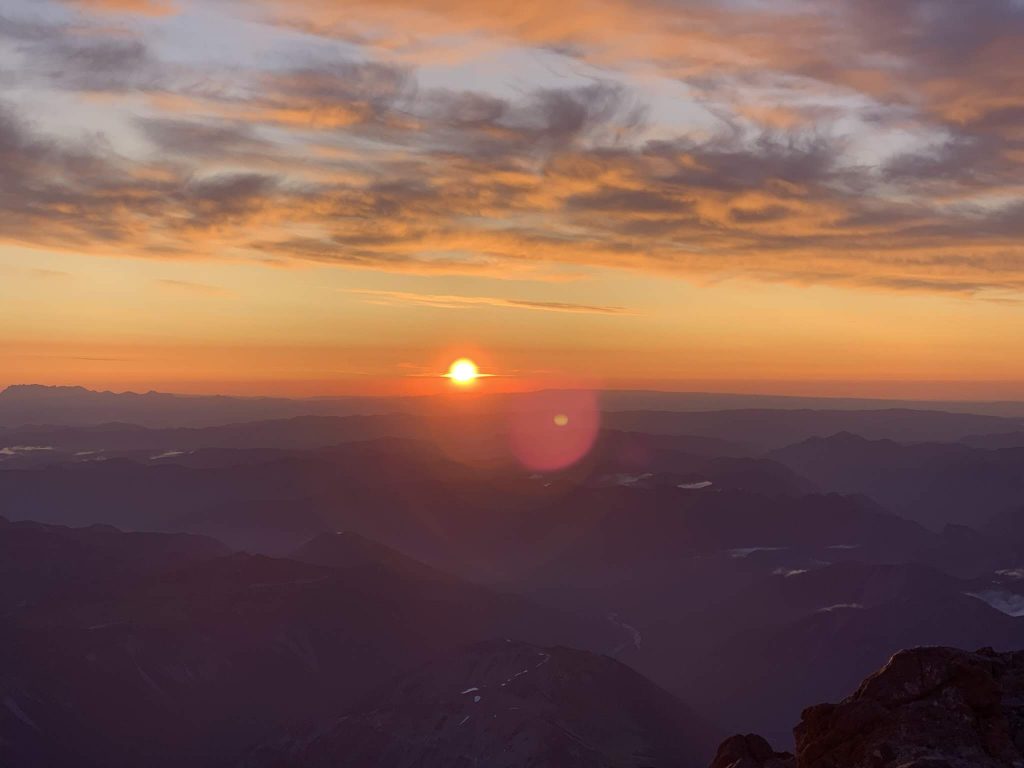

Overall, the upper mountain wasn’t terribly bad. There are some steep, exposed slopes, but I kept my eyes on the path in front of me, ice axe ready, careful with each foot placement to dig my crampons into the hard snow. We leaped a few crevasses, sometimes going uphill, but I only paused momentarily instead of digging in heels. There was one very exposed and very steep section where others had clearly placed pickets. It was clearly a newer route, as the alternative was to negotiate a large crevasse that was apparently opening wider as the season went on. There wasn’t a great foot path here yet, and your feet were essentially at an uncomfortable angle. Of course, this was better than trying to get over the large crevasse, but it was one of the scarier sections. Once on the other side, I asked Noel why we didn’t use pickets there. “We will on the way back, for sure.”



We paused for one final snack break, perched precariously on the steep slope. Other teams had already summited and were making their way down. It was then that I realized that we were one of the last groups still ascending. We were, admittedly, probably the largest group (with 14 people), and our team ranged widely in fitness levels and experience. Since the day was slowly growing warmer, and conditions would become less ideal as a result, we didn’t linger long here.




Shortly after this, we reached the vertical ladder we’d heard about. It served to bridge a widening vertical gap. Noel went up first to make sure it was secure, and the rest of us were prepared to arrest if necessary. I was next. For some reason, the vertical ladder didn’t scare me. Later, Noel would tell me that this should have been the thing to scare me, as it was one of the most dangers parts of the climb. Good thing he didn’t mention that before I placed my foot on the first rung.

From there, it was mostly just switchbacks to the top. While still a tad anxious, my fear had largely subsided by this point. I could tell that my pace had slowed and my breathing became shallower. While I didn’t have any major warning signs of altitude sickness, I could feel the elevation and sensed that it was responsible for me feeling tired. Reaching the crater rim at long last, we had one final challenge: not falling into the gap that rings the crater rim. Hot air rising from the molten belly of this stratovolcano weakens the snow around the crater’s edge. You have to make one last flying leap from rock to the inner crater to avoid dropping down through warmed snow hiding the empty space below.
The Crater Rim and Summit
This wouldn’t be an honest report if I didn’t admit that the very first thing that I did upon reaching the crater was not a dance of joy, not a sigh of relief, not a round of high-fives with my teammates. No, the first thing I did was pull out a blue bag, run as far from the people assembled around the crater as possible without getting too near the edge, situate my pack as the best shield I could engineer, and, well, you know what blue bags are for, right? I was simultaneously humiliated and relieved. I’ve never gone to see a man about a horse so publicly in my life, so that was mortifying, but I’d used every scrap of will power not to shit myself on the ascent, so this felt like a tiny victory in comparison.

Meeting adjourned, I made the trek across the floor of the crater to gain the actual summit, which is still another quarter mile or so away. Partway up that last rocky climb, there’s a summit register. I wrote, “Thank you, Tahoma,” and signed my name. From there, it was just another minute to the true summit, known as Columbia Crest (the two other named peaks on the summit include Point Success, at 14,158’, and Liberty Cap, at 14,112’.)
As I walked onto the true summit, a hot surge of emotion overwhelmed my entire being. I sobbed, but this time with joy. My body shook, overcome. Two teammates, Angela and Kevin, walked over to me. “I never thought I would be here,” I said in a warbled voice through tears. “I never thought I could do something like this.”
Kevin smiled and said, “I can’t believe you made it. I thought for sure you would quit. I can’t believe you kept going, because I could see how scared you were. Can I give you a hug?” I smiled and went in for a hug. It hadn’t occurred to me that others could see how scared I had been. It was, honestly, quite embarrassing to hear someone say they didn’t think I could do it, but Kevin’s words also made it feel like he recognized what I’d had to push through to get myself there, and that he saw this in a positive light. Maybe I could try to look at it from his perspective.
I asked them to snap a summit photo for me. Forgoing the standard ice axe held overhead in triumph pose, I dropped to my knees and folded my hands in a prayer of thanks to the mountain.


We lingered on the summit for some time, dancing, laughing, high-fiving, posing for photos, passing around a can of Rainier beer.

PC: Angela

PC: Angela

PC: Angela

PC: Travis
Stepping away from the team, I took the opportunity to look out in all directions and contemplated the view. The Cascades unfolded in all directions, and the other local volcanoes were in full view. Rivers, which emerge from snow and ice on the flanks of this mountain, meandered far below, making their journey to the Salish Sea. Scanning the valleys and waters below, my eyes sought one particular landmark: Tacoma.
For years, I have looked up at the mountain from below. I see it almost every day from my vantage point in Tacoma. Now, here I was, standing on top of it. I wanted the reverse view. Working my way along the Sound, my eyes made out the city for which I’d been searching. There it was, Tacoma. I was looking back at the place from which I typically stared up at the mountain. I sank to my knees and stared in wonder, smile pressed firmly across my face. I heard Noel whisper, “Let’s give Ellen some alone time on the summit.” The team made their jolly way back down to the crater, leaving me the sole human on the highest point in Washington.
How to capture my thoughts in that time? Perhaps it’s better described as a feeling than thoughts. A profound sense of accomplishment filled me, mixed with the thrill of being on top of this mountain, of having done something I never thought possible for me, and, above all, a feeling of gratitude for the privileged life I live and for the mountain allowing me to stand there. I kept whispering, “thank you, thank you.” It was all I could say. I stared down at Tacoma and the bustling world below and gave thanks with each breath.

As Seth always reminds me, “Going up is optional; coming down is mandatory.” We’d arrived at the crater around 9:30 a.m. and it was now going on 11:00. The sun was shining and the skies were blue, but this also meant that the snow was softening and the route would be at its most dangerous. We were one of the final parties left on the crater that day, which was a clear sign that we needed to start making our way down. With some urgency in his voice, Noel said, “We’ll need to pick up our pace on the way down.”
Before we departed, one team member came up to me and said, strong emotion audible in his voice, “Thanks for not quitting. It’s the only reason I didn’t quit. I told myself, if she can do it and she’s that scared, then I can’t back out. Because of you, I was able to make it to the top. Thank you.” It made me feel good to hear this, to know that I wasn’t alone in being scared. It also made me think differently about being vulnerable and showing my fear. By the end of the excursion, three additional teammates would tell me something along the same lines, that they only kept going because I did. One even mentioned that he was hoping I would quit so that he didn’t have to be the one to initiate quitting. In the end, he was glad that I stubbornly went on, not giving him an excuse to stop.
I try so hard to be tough, someone who fearlessly charges into the wild and shrugs off tough pushes. Crying and outwardly acknowledging my fear to a group of relative strangers is not my M.O. What this experience was showing me was that there is some value in admitting when you’re afraid. It’s something others can relate to, and perhaps your determination to push forward can help them to do the same. Outdoor adventures never cease to offer me life lessons, always challenging me to continue to grow. This was clearly no exception.
The Jogging Descent
Following Noel’s cue, we trotted down the mountain. The snow had turned from icy to slushy, giving crampons and ice axes less purchase. My fear had largely abated, and I wanted to get down as quickly as possible, understanding that the danger of rockfall increased along with the mercury. Noel laughed when we reached the first crevasse and I expertly, and with no hesitation, leaped over it. “Wow, look at you now” he cheered. It was a little easier to get over them going downhill, but I was also at a point where the urgency to get down was more compelling than my fear of falling into a crevasse.
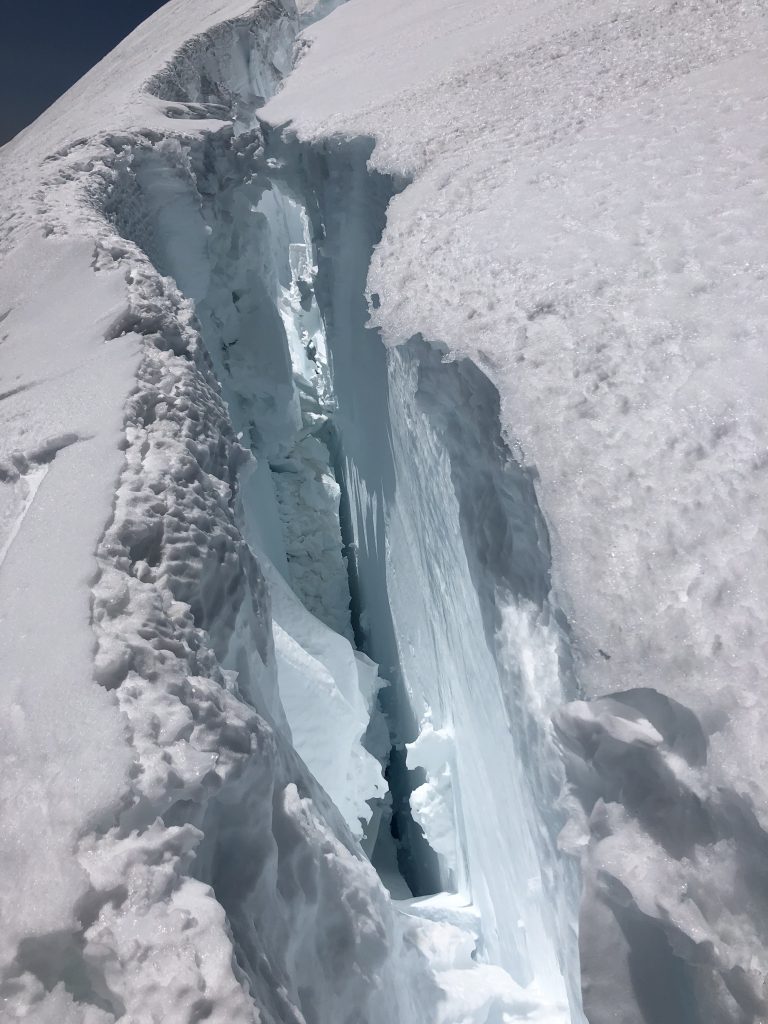
PC: Jen S.
Reaching the vertical ladder, Noel crept down to make sure that it was still stable enough to come down. The anchors were solid enough, which was a good thing, because I have no idea what Plan B would have been. I was the first one down. At the bottom, there was a fixed rope, which I anchored into while waiting for Noel to coach down the rest of our rope team. I stood on a narrow bridge between two gaping crevasses. There was a short wall of snow on one side, which I leaned over and stared into the blue abyss. Water droplets trickled from the melting snow, echoing in the hollow void. Strangely, I felt at ease, and was able to take in the impressive sight, marveling at its beauty and its quiet danger. That will remain one of my favorite impressions from this adventure.

As we arrived at the top of Disappointment Cleaver, we opted to remove our crampons for this rocky section. I find the downclimbing part of rock scrambling much more difficult than going up (which I think is pretty common), plus, now the daylight revealed the exposure along some stretches, and I could see how far down I would plummet in the “just don’t fall” parts. One team member, Travis, kindly helped me negotiate the downclimb, pointing out the best path and steps to take along the way.

Regrouping at the foot of the Cleaver, we roped up and donned crampons again. We had reached the section that is apparently the scariest, and now I could plainly see why. We traversed along the edge of a cliff. To our right, was a wall of snow. To our left, was a sharp drop down to a glacier so heavily crevassed that my mind couldn’t process what my eyes took in. It was a sea of ice and snow, the crevasses like tidal waves. I had never seen anything like it. Similar to my experience in the crevasse the day before, in which I couldn’t help but look down, now I couldn’t peel my eyes away from this remarkable, albeit frightening, sight. It was quintessentially sublime.

We reached what Noel informed us was the most dangerous section of the route. Rockfall could be deadly here, so we needed to get through as quickly as possible. We waited at a relatively safe distance as Harrison’s rope team prepared to go through. Noel grew anxious as they lingered in a vulnerable position instead of making haste. He turned to us and said, “We are not stopping through there. We’re going to move through it as quickly as possible, with no stopping.” The tone of his voice conveyed the seriousness of the situation. According to Noel, this was one of the deadliest spots on the mountain. Fortunately, he told us this after we’d passed through, having given us only enough information as was necessary to reinforce that we couldn’t mess around here. After Harrison’s team was through, we quickly followed.
By the time we reached Ingraham Flats, we were jogging at a good clip. Coming down through Cathedral Gap, I slid on scree in my best imitation of scree dancing. We had one final sketchy section to negotiate, where once again rockfall was a concern. With that final push, we found ourselves back at Camp Muir. For the first time since I tied into that rope, the tension in my muscles fully relaxed.
This Way to Paradise
Our day wasn’t finished yet, though, as we still had to break camp and get back to Paradise. Fortunately, there were some great glissade chutes on the snow field, which saved a lot of time on the way down. Reaching Pebble Creek, Harrison stood sentinel, making sure everyone got down. Our team had spread out, and I linked up with Justin and Dan as we made our way down to Paradise. I was still wearing a rented pair of plastic mountaineering boots, regretting that I hadn’t opted for a little extra weight and carried approach shoes.
In our fatigue and the fallen night, we took a wrong turn, and ended up going the wrong direction on the Skyline Trail. I realized our mistake when the lights of Paradise came into view, but from the wrong direction. Fortunately, I had the map downloaded on my phone and had imported GPX tracks for the route, which I used to get us going back in the right direction. While I had been the scared, crying woman on the mountain, I was now in my wheelhouse and was glad that I at least knew how to navigate us out of there.
At this point, we were toast and had very little left to give. Justin tried to make small talk to distract us, but Dan and I could hardly reply. I had an iron focus on getting down to Paradise and out of these boots. When snow gave way to pavement, we picked up the best run we could manage. I wouldn’t let myself imagine what my feet were going to look like. At long last, we trotted into Paradise, where some other team members were waiting.
Jen was still on the mountain, helping a struggling team member to get down, so I put on all my layers and waited on the picnic table. Shivering, I climbed into my sleeping bag, too. I must have been a little out of it, because I didn’t realize that the table was soaking wet, and the moisture soaked through the sleeping bag as well as all of my clothes. Noel pulled up, and I climbed into his car with the heat blasting, trying to warm up. Jen was still up there, and everyone else was heading to Seattle. Had I been dry, I would have curled up next to her car and slept until she got down. Being soaked through and shivering, though, all I wanted was to stay warm. This long and taxing day just wasn’t through with me yet, it seemed.
In an odd coincidence, some climbers I’d met in the hut at Camp Muir pulled up looking for their friend, who was with Jen. They had to get back to Tacoma and were concerned about him. Reassuring them he was fine and that Jen would bring him home (somehow, Seth was able to deliver messages between me and Jen, although she and I couldn’t reach each other), I asked if they could give me a lift to Tacoma. They were more or less strangers, but they were so concerned about their own friend’s safety that I convinced myself they were good people who wouldn’t murder me. Noel reluctantly let me leave with them, and I assured him that they were ok.
Turns out, they were both very nice. We chatted to keep the driver awake, but we were all exhausted, and it took a lot of effort. I pulled the plastic boots off for sweet relief; my feet swelled terrible, but there was no way that I was putting those things back on. We pulled in front of my house around 3:00 a.m. and, barefoot, I dragged myself inside for some hard-earned sleep.
Reflections
Climbing Tahoma was one of the most challenging experiences of my life. Like rock climbing and rappelling, I find mountaineering scary. I’m afraid of heights and have trouble with vertigo. It’s all very firmly Type 2 Fun. It’s really never Type 1 Fun, fun in the moment. Climbing and mountaineering don’t come naturally or easily to me; they take a lot of hard work, both mentally and physically. They require that I dig quite deep and push myself beyond my perceived limits and certainly out of my comfort zone. As much as I love to run, it doesn’t challenge me in this way.
And, yet, for some strange reason, I keep doing these things. They don’t bring the instant pleasure of a great ridge run or gnarly bushwhack, but they must provide something I need, or want, because before I went to sleep that night, I thought to myself, “I wonder what other climbs Harrison and Noel might lead next?”
Perhaps, in the end, I seek a means for breaking through a wall of fear. I don’t want fear to hold me back, whether that’s in taking a leap across a crevasse, or taking a figurative leap and starting a new life. Maybe rock climbing and mountaineering aren’t necessarily fun-fun, but they do embolden me in ways I’ve never thought possible. Turning 40, the inciting incident that led me to climb Rainier in the first place, forced me to reflect on what I have done with my life so far. I haven’t accomplished all that I’d hoped, or dreamed, and I feel a sense of urgency to make the second half of my life better, and more fulfilling, than the first half. Maybe forcing myself to confront my fears in nature will give me the strength to tackle the daunting prospect of starting a new life. Like jumping over a gaping maw in the snow, it’s frightening in the moment, and it’s hard to take that leap, but it’s quite a thrill once you get yourself to the other side. And, if you don’t quite clear the gap, then you can take comfort in knowing that you have a team there ready to catch you, and to help you pull yourself out from the void.
Many thanks to everyone who made this experience possible. To Harrison for putting together a great team and managing most of the logistics; to Noel for his guidance and support and for getting me up that mountain one rest break at a time; to my teammates for sharing the experience with me, and for providing many of the photos used here; to those guys who drove me home in the middle of the night despite my stinking feet; to my climbing partners, Terry, Charles, and Jim, for coaching me into a better rock climber; and to Seth, for helping me practice my mountaineering skills, teaching me how to self-arrest, and letting me borrow much of the gear that I schlepped up the mountain. Finally, thanks to the mountain itself, for everything.

Photo credit: Seth Wolpin
